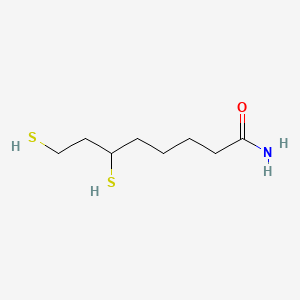| MeSH term | MeSH ID | Detail |
|---|---|---|
| Parkinsonian Disorders | D020734 | 20 associated lipids |
Dihydrolipoamide
Dihydrolipoamide is a lipid of Fatty Acyls (FA) class. Dihydrolipoamide is associated with abnormalities such as Wiskott-Aldrich Syndrome. The involved functions are known as Citric Acid Cycle, Electron Transport, NADH oxidation, Oxidation and Oxidants. Dihydrolipoamide often locates in Mitochondria, Mitochondrial matrix and Chloroplasts. The associated genes with Dihydrolipoamide are Mutant Proteins, Recombinant Proteins, mycothione reductase, Genes, Mitochondrial and alanylproline.
Cross Reference
Introduction
To understand associated biological information of Dihydrolipoamide, we collected biological information of abnormalities, associated pathways, cellular/molecular locations, biological functions, related genes/proteins, lipids and common seen animal/experimental models with organized paragraphs from literatures.
What diseases are associated with Dihydrolipoamide?
Dihydrolipoamide is suspected in and other diseases in descending order of the highest number of associated sentences.
Related references are mostly published in these journals:
| Disease | Cross reference | Weighted score | Related literature |
|---|
Possible diseases from mapped MeSH terms on references
We collected disease MeSH terms mapped to the references associated with Dihydrolipoamide
PubChem Associated disorders and diseases
What pathways are associated with Dihydrolipoamide
There are no associated biomedical information in the current reference collection.
PubChem Biomolecular Interactions and Pathways
Link to PubChem Biomolecular Interactions and PathwaysWhat cellular locations are associated with Dihydrolipoamide?
Visualization in cellular structure
Associated locations are in red color. Not associated locations are in black.
Related references are published most in these journals:
| Location | Cross reference | Weighted score | Related literatures |
|---|
What functions are associated with Dihydrolipoamide?
Related references are published most in these journals:
| Function | Cross reference | Weighted score | Related literatures |
|---|
What lipids are associated with Dihydrolipoamide?
There are no associated biomedical information in the current reference collection.
What genes are associated with Dihydrolipoamide?
Related references are published most in these journals:
| Gene | Cross reference | Weighted score | Related literatures |
|---|
What common seen animal models are associated with Dihydrolipoamide?
There are no associated biomedical information in the current reference collection.
NCBI Entrez Crosslinks
All references with Dihydrolipoamide
Download all related citations| Authors | Title | Published | Journal | PubMed Link |
|---|---|---|---|---|
| Vyas PM and Payne RM | TAT opens the door. | 2008 | Mol. Ther. | pmid:18362922 |
| Stensballe A et al. | The amyloplast proteome of potato tuber. | 2008 | FEBS J. | pmid:18331355 |
| Yan LJ et al. | Changes in dihydrolipoamide dehydrogenase expression and activity during postnatal development and aging in the rat brain. | 2008 | Mech. Ageing Dev. | pmid:18316113 |
| Batista AP et al. | The dihydrolipoamide dehydrogenase from the crenarchaeon Acidianus ambivalens. | 2008 | FEMS Microbiol. Lett. | pmid:18312361 |
| Mary-Huard T et al. | Statistical methodology for the analysis of dye-switch microarray experiments. | 2008 | BMC Bioinformatics | pmid:18271965 |
| Chakraborty S et al. | Characterization of a dihydrolipoyl dehydrogenase having diaphorase activity of Clostridium kluyveri. | 2008 | Biosci. Biotechnol. Biochem. | pmid:18391450 |
| Rapoport M et al. | TAT-mediated delivery of LAD restores pyruvate dehydrogenase complex activity in the mitochondria of patients with LAD deficiency. | 2008 | Mol. Ther. | pmid:18362926 |
| de Berardinis V et al. | A complete collection of single-gene deletion mutants of Acinetobacter baylyi ADP1. | 2008 | Mol. Syst. Biol. | pmid:18319726 |
| Yukumi S et al. | Feasibility of induction heating using a sintered MgFe2O4 needle for minimally invasive breast cancer therapy. | 2008 Jan-Feb | Anticancer Res. | pmid:18383826 |
| Kurakin A | Scale-free flow of life: on the biology, economics, and physics of the cell. | 2009 | Theor Biol Med Model | pmid:19416527 |
| Wu TF et al. | Proteomic investigation of the impact of oxygen on the protein profiles of hyaluronic acid-producing Streptococcus zooepidemicus. | 2009 | Proteomics | pmid:19688725 |
| Ambrus A et al. | Inhibition of the alpha-ketoglutarate dehydrogenase-mediated reactive oxygen species generation by lipoic acid. | 2009 | J. Neurochem. | pmid:19393031 |
| Marino SM and Gladyshev VN | A structure-based approach for detection of thiol oxidoreductases and their catalytic redox-active cysteine residues. | 2009 | PLoS Comput. Biol. | pmid:19424433 |
| White JR et al. | Statistical methods for detecting differentially abundant features in clinical metagenomic samples. | 2009 | PLoS Comput. Biol. | pmid:19360128 |
| Yan LJ and Forster MJ | Resolving mitochondrial protein complexes using nongradient blue native polyacrylamide gel electrophoresis. | 2009 | Anal. Biochem. | pmid:19348780 |
| Keyes BE and Burke DJ | Irc15 Is a microtubule-associated protein that regulates microtubule dynamics in Saccharomyces cerevisiae. | 2009 | Curr. Biol. | pmid:19285398 |
| Brautigam CA et al. | Subunit and catalytic component stoichiometries of an in vitro reconstituted human pyruvate dehydrogenase complex. | 2009 | J. Biol. Chem. | pmid:19240034 |
| Xi Y et al. | Analysis on relationship between extreme pathways and correlated reaction sets. | 2009 | BMC Bioinformatics | pmid:19208161 |
| Chi F et al. | Identification of IbeR as a stationary-phase regulator in meningitic Escherichia coli K1 that carries a loss-of-function mutation in rpoS. | 2009 | J. Biomed. Biotechnol. | pmid:19300523 |
| Griffin JL and Des Rosiers C | Applications of metabolomics and proteomics to the mdx mouse model of Duchenne muscular dystrophy: lessons from downstream of the transcriptome. | 2009 | Genome Med | pmid:19341503 |
